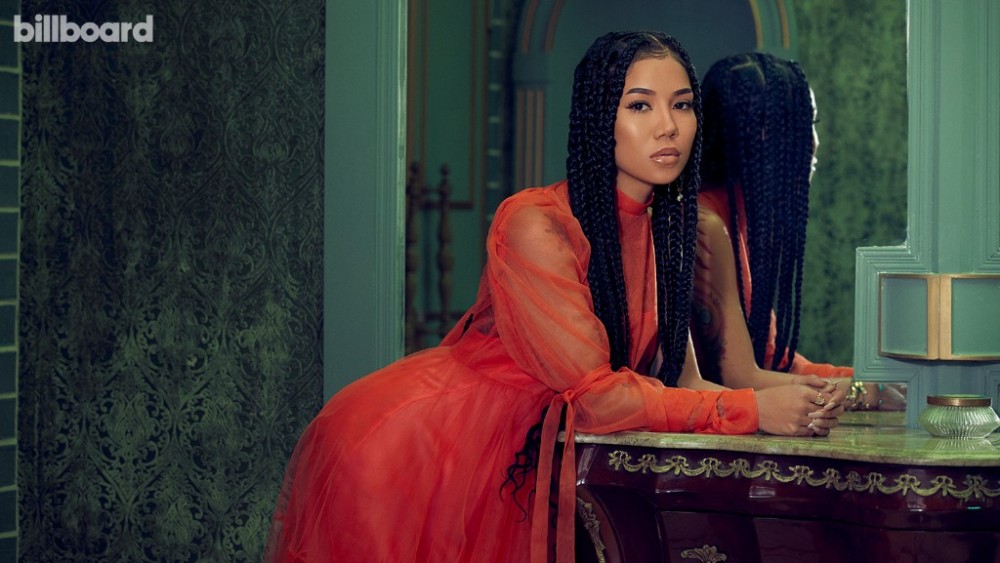How the use of sound bowls turned Jhené Aiko’s new album into one “free-flowing jam session.”
Jhené Aiko is burning incense inside New York’s Germano Studios in NoHo, preparing the space for a listening session of her upcoming album, Chilombo, out March 6 on Def Jam. She wants the energy to be pure; after all, the record is Aiko’s first deep dive into the idea of sound healing. During the creative process for her third album, the experimental R&B singer was adamant about incorporating crystal alchemy sound bowls — which produce an extended vibrational hum — on each track. Her hope was to open up different chakras within the human body.
“For instance, ‘P*$$Y Fairy (OTW)’ ” — the album’s punchiest and most provocative track — “is in the key of D, so I played a bowl in the note of D, and that governs your sexuality,” explains Aiko weeks after the listening session. “It helps balance out your sexual organs like your navel and your hips. So even though the song is fun and sexy, there’s an actual instrument in there inspiring that energy].”
It’s not the first time Aiko, 31, has explored sound bowls: Last September, she uploaded a six-minute meditation called “Trigger Protection Mantra” to Instagram. Chilombo is, however, Aiko at her most confident in the practice.
The Los Angeles-bred singer, born Jhené Aiko Efuru Chilombo, first gained mainstream attention with her 2011 mixtape, Sailing Souls, which she released independently. It boasted features from Drake, Kendrick Lamar and Kanye West. By the end of the year, Aiko had signed a recording contract with ARTium, producer No I.D.’s Def Jam-distributed label. Her 2013 single, the piano-led “The Worst” (off the EP Sail Out), established her as a compelling new voice as she sang: “I do not depend on nothing or no one.”
When her 2014 debut full-length, Souled Out, hit Nos. 1 and 3 on the Top R&B/Hip-Hop Albums chart and the Billboard 200, respectively, Aiko cemented her place as one of R&B’s rising stars. She set herself apart from the rest with the hazy, psychedelic Trip, a surprise drop that arrived in 2017 and landed in the Billboard 200’s top five — without a publicity push.
Trip’s success helped inform the “off-cycle” streaming strategy that she and her team employ today, in which they intentionally release a new track just outside of the window when streaming platforms typically update playlists, which “is liberating from a pressurized playlisting strategy,” says Def Jam GM/executive vp Rich Isaacson. “It’s important to her that each track release is its own ecosystem. Jhené and her team feed each one with unique content strategies to prolong the life cycle, and over the course of eight to 10 to 12 months of steady consumption, she racks up really impressive numbers.”
Even without maximizing a track’s immediate exposure on streaming services, the three singles already released from Chilombo — which finds middle ground between her early, more traditionally styled R&B with the atmospheric sounds of Trip — have collectively garnered 363 million streams, according to Nielsen Music/MRC Data. It doesn’t hurt that the first two singles before “P*$$Y Fairy (OTW)” fueled speculation over Aiko’s relationship status with on-again-off-again partner Big Sean. Lead single “Triggered” arrived last May and offered a gripping take on how bad habits in previous relationships tarnished Aiko’s outlook on love, leaving fans to assume that she was trashing the rapper. It became her highest-charting Hot R&B Songs solo hit, landing at No. 3; six months later, she upended expectations with her Big Sean collaboration “None of Your Concern.” Elsewhere, Aiko enlists Future and Miguel on the savory “H.O.E. (Happiness Is Everything),” and on the sobering “10K Hours,” featuring Nas, she seeks peace and restoration.
Aiko, who will head out on tour this May, believes the notion of the phrase “none of your concern,” in particular, extends well beyond her love life, saying that self-discovery played a crucial role in the creation of Chilombo, for which she trekked to Hawaii to record. It was there that she decided to turn her last name into the album title. “ ‘Chilombo’ is a word that means ‘wild beast’ — they’re strong, confident and grateful,” she says. “Beasts are also beautiful.”
She likens herself to the many active volcanoes that surrounded her while she recorded on the Big Island, saying: “In a sense, I am like a volcano, and this album is an eruption. It starts with ‘Triggered,’ and there’s a lava flow with all these songs where it’s a free-flowing jam session. We didn’t settle — and it became this beautiful land where there’s new life.”
Sound Bowls: Explained
While recording her third album, Chilombo, Jhené Aiko used sound bowls, commonly known as singing bowls. When struck or shaken, they release a vibrational hum that resonates throughout the body, producing a calming and tranquil effect. Singing bowls are a common practice in healing and meditation, as they promote chakra balancing as well as stress and anxiety reduction. Here, Aiko shares how they influenced her sound.
This album] is an introduction to sound bowls for people who don’t really know about them — this is me introducing my newfound love. These bowls are crystal alchemy sound bowls, so they are made from gemstones. Gemstones are fused with things like platinum or made out of rubies and diamonds — and all of these different elements and properties contribute to their healing factors. I basically was recording and had a session at my house where I just played different bowls to the music; every chakra has a note that corresponds to music. For instance, on “P*$$Y Fairy (OTW),” there’s actually two bowls in there: There’s a D bowl and there’s an A bowl, and they’re both playing and resonating within your body when you’re listening to that song.
There are bowls on every single song on this album. Some of them you can hear more than others, but they are throughout the whole album. Obviously, there’s other instruments, and this isn’t solely] a healing album — the bowls were just a component I wanted to add because this is something that I’m moving forward with. You’ll see a lot more of me owning this.
I’m still in transition, but I’m still me. I still love to write all types of songs and listen to all types of music, but Chilombo definitely has a lot more acoustic instruments because I wanted it to be music that you can feel. You can hear what the mic was picking up in the room. Everyone was playing actual instruments, and] those resonate with you differently than digital. Chilombo is all of my projects that I put out prior to this combined. This is the baby — but it’s the evolved version.
This article originally appeared in the Feb. 29, 2020 issue of Billboard.



